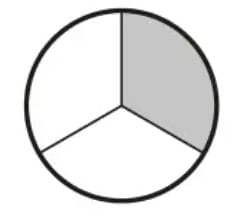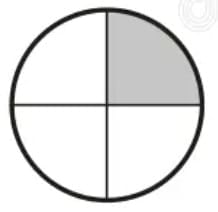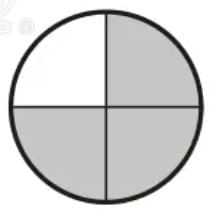Unit Test (Solutions): Fractions | Mathematics (Maths Mela) Class 5 - New NCERT PDF Download
Time: 1 hour
M.M. 30
Attempt all questions.
- Question numbers 1 to 5 carry 1 mark each.
- Question numbers 6 to 8 carry 2 marks each.
- Question numbers 9 to 11 carry 3 marks each.
- Question number 12 & 13 carry 5 marks each
Q1. Which of the following fractions is equal to 1/2? (1 Mark)
(a) 2/3
(b) 3/6
(c) 4/5
(d) 5/8
Answer: (b) 3/6
Q2. The numerator of 7/9 is: (1 Mark)
(a) 7
(b) 9
(c) 16
(d) 2
Answer: (a) 7
Q3. Which of the following fractions is equivalent to 4/6? (1 Mark)
(a) 2/3
(b) 3/2
(c) 6/4
(d) 5/6
Answer: (a) 2/3
Q4.If a pizza is cut into 12 equal slices and 3 slices are eaten, what fraction of pizza is left? (1 Mark)
(a) 3/12
(b) 9/12
(c) 12/3
(d) 6/12
Answer: (b) 9/12
Q5. 2/3 of 9 is equal to: (1 Mark)
(a) 2
(b) 3
(c) 4
(d) 6
Answer: (d) 6
Q6: Write the fraction whose: (2 Marks)
(i) Numerator is 7 and denominator is 15.
(ii) Numerator is 22 and denominator is 35.
Ans:
(i) 7/15
(ii) 22/35
Q7: Divide each collection into a suitable number of equal parts and fill in the blanks: (2 Marks)
(i) 5/6 of 18 = __________
(ii) 1/8 of 16 = __________
Ans:
(i) 5/6 of 18 = 15
(ii) 1/8 of 16 = 2
Q8: In each of the following, write the fraction representing the shaded portion: (2 Marks)
(i) 1/3
(ii) 1/4
(iii) 3/4
Ans: (i)

(ii) 
(iii)
Q9: Fill in the missing numerators: (3 Marks)
(i) ?/21 = 5/7
(ii) ?/10 = 1/2
(iii) ?/15 = 1/3
Ans:
(i) ?/21 = 5/7
→ Numerator = 15
(ii) ?/10 = 1/2
→ Numerator = 5
(iii) ?/15 = 1/3
→ Numerator = 5
Q10: Find an equivalent fraction of 3/4 with: (3 Marks)
(i) Numerator 15
(ii) Denominator 48
(iii) Denominator 24
Ans:
(i) Numerator 15 → 15/20
(ii) Denominator 48 → 36/48
(iii) Denominator 24 → 18/24
Q11: Encircle the fraction which is in its lowest terms: (3 Marks)
(i) 12/18, 5/7, 9/15
(ii) 4/10, 11/13, 8/12
Ans:
(i) 5/7
(ii) 11/13
Q12: Write the next three equivalent fractions of each of the following: (5 Marks)
(i) 1/4
(ii) 2/3
(iii) 5/9
(iv) 4/7
Ans:
(i) 1/4 → 2/8, 4/16, 8/32
(ii) 2/3 → 4/6, 8/12, 16/24
(iii) 5/9 → 10/18, 20/36, 40/72
(iv) 4/7 → 8/14, 16/28, 32/56
Q13: Which is smaller in each of the following pairs of fractions? (5 Marks)
(i) 3/16, 21/32
(ii) 18/25, 2/5
(iii) 8/21, 7/20
(iv) 3/16, 21/32
(v) 18/25, 2/5
Ans:
(i) 3/16, 21/32
Ans: We need to make the denominator equal first,
3/16 × 2/2 = 6/32
6/32 < 21/32
∴ 6/32 is smaller than 21/32
(ii) 18/25, 2/5
Ans: We need to make the denominator equal first,
2/5 × 5/5 = 10/25
18/25 > 10/25
∴ 18/25 is smaller than 10/25
(iii) 8/21, 7/20
Ans: We need to make the denominator equal first,
LCM of 21 and 20 = 420
8/21 × 20/20 = 160/420
7/20 × 21/21 = 147/420
So, 147/420 < 160/420
∴ 7/20 is smaller than 8/21
(iv) 3/16, 21/32
Ans: We need to make the denominator equal first,
3/16 × 2/2 = 6/32
6/32 < 21/32
∴ 3/16 is smaller
(v) 18/25, 2/5
Ans: We need to make the denominator equal first,
2/5 × 5/5 = 10/25
10/25 < 18/25
∴ 2/5 is smaller
|
35 videos|318 docs|7 tests
|
FAQs on Unit Test (Solutions): Fractions - Mathematics (Maths Mela) Class 5 - New NCERT
| 1. What are fractions and how are they classified? |  |
| 2. How do you add and subtract fractions? |  |
| 3. What is the procedure for multiplying fractions? |  |
| 4. What is the method to divide fractions? |  |
| 5. How do you convert a fraction into a decimal? |  |
















